German Unity Day (Tag der Deutschen Einheit) is celebrated every year on October 3rd. This year the celebrations will centre around Berlin, which will host a three-day festival. As the whole of Germany turns to Berlin, we have taken a look at GDR monuments which remain in Berlin as remnants of the former socialist city and what they represent for both today’s unified Germany and the new Berlin.
Ernst Thälmann Statue
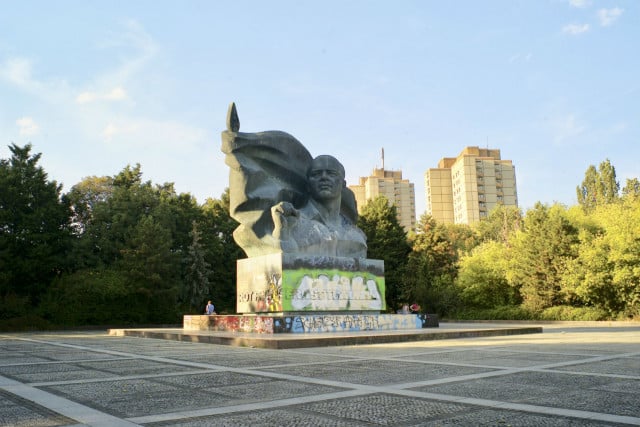
The Ernst Thälmann monument in front of its Plattenbau backdrop. Photo: Laura Peacock
Situated in Ernst Thälmann Park in Berlin’s Prenzlauer Berg, this huge 15m tall bronze statue was built between 1981 and 1986 by the Soviet sculptor Lew Kerbel. It is surrounded by towering Plattenbauten which were all built as part of the park complex: a project which aimed to be a showcase for socialist living.
The statue depicts Thälmann who was the leading figure of the Communist party (KPD) in Weimar Germany. He was killed in Buchenwald concentration camp in 1944. A significant figure in the GDR, he symbolised communism's struggle to overcome fascism.
Following the fall of the Berlin wall, it was initially recommended by the Berlin Senate Historical Commission that the Thälmann statue be removed but this never happened. However, the City of Berlin did not take responsibility for the monument until 2006, and despite it gaining listed status in 2014, its large granite base remains constantly covered in graffiti.
The statue has not remained in Berlin without controversy, but is now set to last as a symbol of the GDR in modern day Berlin. For some, Thälmann was a radical left-wing, anti-democratic politician, but for others his continued presence in Berlin represents Germany’s strength overcoming a history of continued division.
Marx-Engels Forum
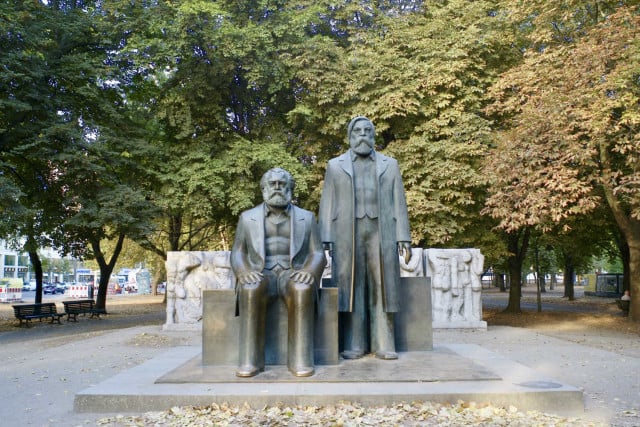
The Marx-Engels Forum has become a popular tourist selfie spot. Photo: Laura Peacock
The Marx-Engels forum was officially opened in April 1986 in the heart of East Berlin, next to the Palast der Republik. It is not built in the same typically-Soviet heroic style as the Thälmann monument and is instead more understated.
Marx and Engels are depicted in the main statue of the Forum, Marx sitting and Engels standing, in statues about twice lifesize. This statue has become a tourist hotspot, with many posing to have their photos taken, sometimes even sitting on Marx’s knee.
The Forum has in fact been moved since the fall of the wall to make space for the development of the U5 U-Bahn line in Berlin and now, instead of looking out towards Alexanderplatz and the East, Marx and Engels gaze over the Spree towards the former West Berlin.The location of Marx and Engels is still under discussion and where they will end up is unknown.
Soviet War Memorial, Treptower Park
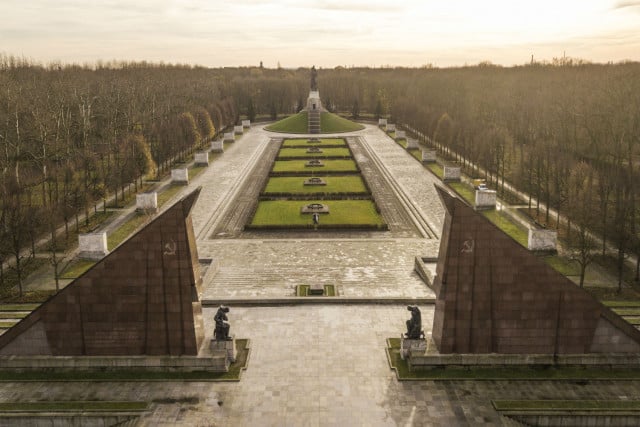
The vast size of the war memorial is shown from above. Photo: DPA
The sprawling burial site of over 7000 Soviet soldiers who died in the battle for Berlin at the end of the Second World War, the Soviet War Memorial in Treptower Park was ceremonially opened in May 1949
It has 5 different statue aspects, with the centrepiece being a huge 12 metre high bronze statue of a Soviet soldier standing on a broken swastika and carrying a child. This is either a depiction of a soldier rescuing a child from the rubble, or the child has been seen to represent the Soviets carrying socialism to Germany.
The memorial complex is vast and the Socialist Realism style is evident. The inscriptions on the monuments all emphasise the message that those who died did so as heroes and saved Europe from fascism. The memorial became a reminder not only for the dead, but for the founding ideals of the GDR.
Today the memorial remains a place where the Soviet dead are remembered, and flowers and other gifts are often left at the bottom of the pedestal underneath the large bronze statue. On May 9th every year the Treptower memorial has thousands of visitors as Russia celebrates its Victory Day and remembers its fallen World War II soldiers.
Spanienkämpfer
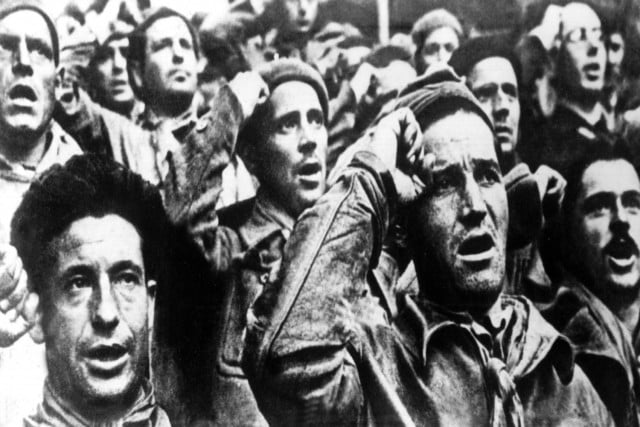
The International Brigades march through Barcelona in 1936. Photo: DPA
Erected in Volkspark Friedrichshain in 1968 the “Spanish Fighter” commemorates the German members of the International Brigades who fought between 1936 and 1939 in the Spanish Civil War.
Thousands of volunteers flocked to Spain to support the Republican armed forces in the war, including a significant number of German Communists. This came to be an important narrative in the GDR. The International Brigades came to be synonymous with GDR history, politics and ideology as a kind of founding myth.
There are three elements to the memorial: a plaque, a bronze relief and the bronze figure. The bronze figure is shown jumping from the trenches, sword raised. The figure references Ernst Barlach’s 1914 statue Der Rächer (The Avenger), an artist whose works were deemed by the Nazis as 'degenerate' and were therefore confiscated.
Today the Spanienkämpfer represents both the memory of the German members of the International Brigades, but more importantly the great significance that the events were given in the GDR, as they searched for myths around which to build their collective memories.
Lenin’s Head, Spandau Citadel
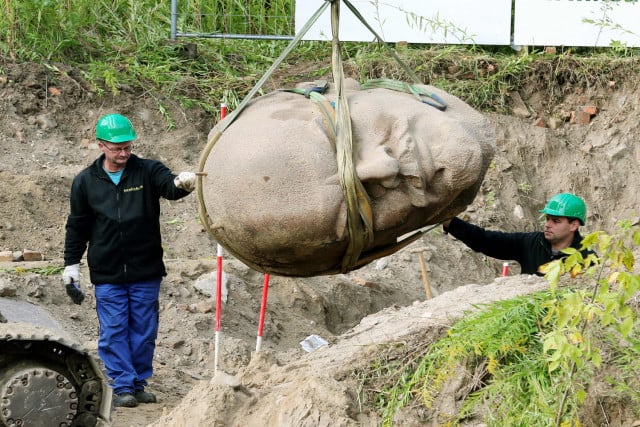
A specialist team digs up the head of the Lenin statue for the Spandau Citadel Exhibition, 2015. Photo: DPA
After the Wende, numerous Lenin statues across the GDR were removed and they all disappeared from East Berlin. In 1991, the 19 metre high, red granite statue - which had been built in April 1970 - on Leninplatz in Friedrichshain was dismantled.
It was broken up into 129 parts, all of which were buried in the woods southeast of Berlin in Müggelheim. Leninplatz was also renamed as Platz der Vereinten Nationen.
This was not the end of the story though, as in 2009 plans began for an exhibition in Spandau which might involve the statue being dug up. There was a lot of controversy about this, and at one point the authorities even claimed that they did not know where the statue had been buried.
However, in 2015 the head of the statue was dug up and is now featured in the Spandau Citadel permanent exhibition Revealed, Berlin and its Monuments.
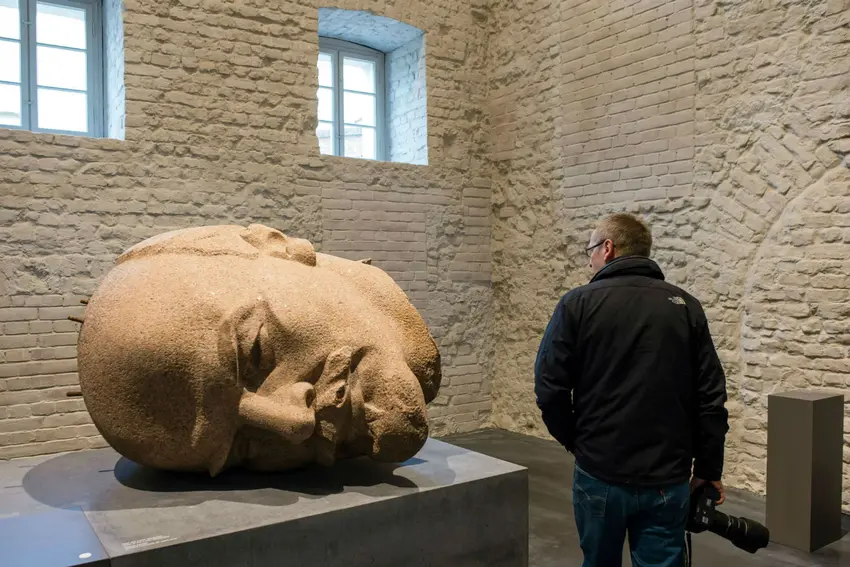
Comments